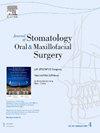脱细胞真皮基质同时植入的疗效:临床试验的系统回顾和荟萃分析。
IF 2
3区 医学
Q2 DENTISTRY, ORAL SURGERY & MEDICINE
Journal of Stomatology Oral and Maxillofacial Surgery
Pub Date : 2025-04-11
DOI:10.1016/j.jormas.2025.102371
引用次数: 0
摘要
目的:种植体上的垂直软组织厚度对于长期手术成功和上颌骨软组织成分的生物整合至关重要,因此,需要开发自体软组织移植物的替代品,如异体和异种移植物。脱细胞真皮基质(ADM)在软组织增大、萎缩和增加角质组织宽度中为血管生成、血管重建和组织重塑提供结构支持。在这一点上,本系统综述的目的是评估在增加ADM与种植体结合后获得的软组织高度(STH)。方法:系统检索5个数据库。主要结局指标是STH变化。次要结果包括种植体部位的边缘骨丢失(MBL)和口袋探测深度(PPD)。结果:meta分析包括6项研究,200名参与者,并报告了植入物周围垂直组织厚度、MBL和PPD的术前和术后平均水平。STH的合并平均差(MD)为0.84 (95% CI:0.28 ~ 1.39), p值< 0.0001。共有三项研究报道了MBL。种植体周围MBL的总MD,比较从基线到12个月的平均变化。随机效应模型显示MD为0.07mm (95% CI: -0.21 ~ 0.35 mm, p= 0.6325)。计算种植体部位PPD的总MD,比较三个研究中ADM组与对照组的差异;随机效应模型显示MD为-0.13mm (95% CI: -0.47 ~ 0.22 mm, p= 0.4742)。结论:脱细胞真皮基质可显著改善软组织垂直厚度,但对边缘骨丢失及穿刺深度无显著影响。本文章由计算机程序翻译,如有差异,请以英文原文为准。
Efficacy of Acellular dermal matrix simultaneous with implant placement: A systematic review and meta-analysis of clinical trials
Purpose
The vertical soft tissue thickness over the implant is essential for long-term procedure success and for biological integration of the suprabony soft tissue component, consequently, development of alternatives to autogenous soft tissue grafts such as allogeneic and xenogeneic grafts were needed. Acellular dermal matrix (ADM) is utilized to provide structural support for angiogenesis, revascularization and tissue remodeling in soft tissue augmentation, recession, and increasing the keratinized tissue width. At this point, the aim of this systematic review was to evaluate the amount of soft tissue height (STH) gained after augmenting the ADM in combination with the dental implants. Methods: A systematic search was performed in five databases. The primary outcome measure was STH change. Secondary outcomes included marginal bone loss (MBL) and pocket probing depth (PPD) at implant sites. Results: Six studies, with 200 participants, and reported pre- and post-operative mean of vertical tissue thickness, MBL, and PPD around implants were included in the meta-analysis. The pooled mean difference (MD) of STH was 0.84 (95 % CI:0.28 to 1.39) with a p-value < 0.0001. A total of three studies, reported MBL. The pooled MD of MBL around implants, comparing the mean change from baseline to 12 months. The random effect model revealed a MD of 0.07mm (95 % CI: -0.21 to 0.35 mm, p= 0.6325). Calculation of pooled MD of PPD at implant sites, comparing ADM groups to the control groups in three studies; the random effect model revealed a MD of -0.13mm (95 % CI: -0.47 to 0.22 mm, p= 0.4742).
Conclusion
While Acellular dermal matrix significantly improves vertical soft tissue thickness, it does not significantly impact marginal bone loss or pocket probing depth.
求助全文
通过发布文献求助,成功后即可免费获取论文全文。
去求助
来源期刊

Journal of Stomatology Oral and Maxillofacial Surgery
Surgery, Dentistry, Oral Surgery and Medicine, Otorhinolaryngology and Facial Plastic Surgery
CiteScore
2.30
自引率
9.10%
发文量
0
审稿时长
23 days
 求助内容:
求助内容: 应助结果提醒方式:
应助结果提醒方式:


